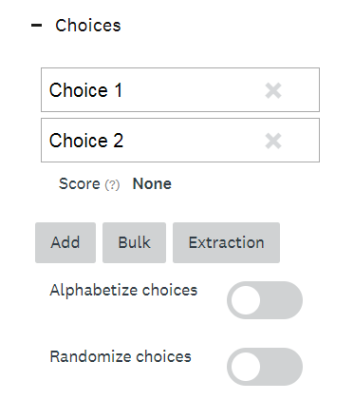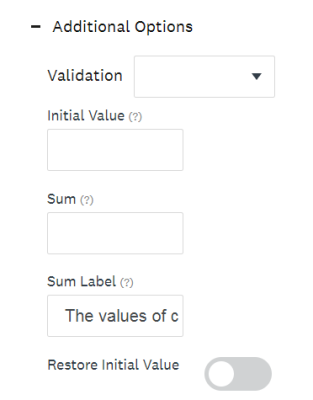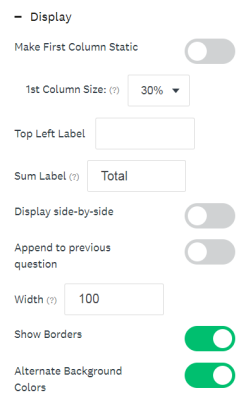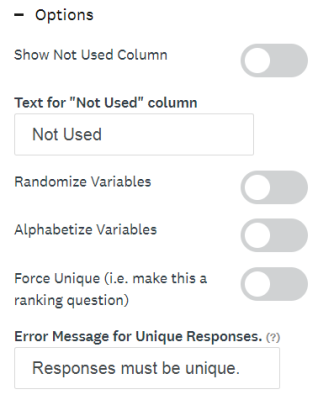Apply
Multi-Column Question
A Multi-Column question can have different question types within each column. An example of this would be asking an Applicant for Educational History. Each Row would be for a different Educational Institution and each column can be used to gather information about that Institution.
How to Add a Multi-Column Question
- Within your form, click on the Questions tab in the top left corner
- Under Advanced Questions, double-click or click and drag the Multi-Column question to add it to your form.
- Optional: Add an Identifier to your question
- Enter the Question Title
- Optional: Add a Description
- Select your Column Types to add
- Add your Rows. You can add the Rows individually by clicking Add or by clicking the Bulk button. You can add the variables in a list within the Bulk Editor.
i. Decide if the Row will be Required or Optional - Set the Column Settings
- Set the +Display settings
- Set the +Options settings
NOTE: You can add the Choices individually by clicking Add or by clicking the Bulk button. You can add the variables in a list within the Bulk Editor. You can also Add Other Choice which will automatically add a choice with an additional text response field to collect more information.
How to Set Up each Column Type
Within the Multi-Column Question you will be able to choose between 4 different types of Columns:
- Dropdown
- Text Response
- Checkbox
- Radio Buttons
Dropdown
- Decide if the Variable will be Required or Optional
- Select the Blank Choice for the dropdown, this is the first choice in the dropdown list and will represent no response given.
- Add your Choices. You can add the Choices individually by clicking Add or by clicking the Bulk button. You can add the variables in a list within the Bulk Editor.
- Set your Choice Settings
Text Response
- Decide if the Variable will be Required or Optional
- Decide if the text response will be Multiline.
- Set the Column width of the text field
- Set +Additional Options
Checkbox
There are no additional steps for the Checkbox Column.
Radio Buttons
- Decide if the Variable will be Required or Optional
- Select the Appearance of the buttons: Vertical, Horizontal, Star Rating, or Combo Box
- Add your Choices. You can add the Choices individually by clicking Add or by clicking the Bulk button. You can add the variables in a list within the Bulk Editor.
- Set your Choice Settings
Column Settings
Choice Settings
These Settings are applicable to:
- Dropdown
- Radio Buttons

| Choice Settings | Description |
| Score | Scoring allows you to assign a value to each choice. This is commonly used in Advanced Review Forms. Choices will have Default Scoring applied automatically. |
| Randomize Choices | Selecting this option randomizes the choices upon each form refresh. |
| Alphabetize choices | Choices within your list will follow alphabetical order (A-Z). TIP! Use this if you are going to be adding choices to your form after already collecting data. This will allow you to maintain your alphabetical order without jeopardizing your data. Refer to How to Safely Make Changes to a Live Form for more information. |
Additional Options
These Settings are applicable to:
- Text Response

| Additional Options | Descriptions |
| Validation | Add a restriction to what the user must enter into the field. For example, if you want to collect email addresses, then select email validation. Refer to How to Add Validation to a Text Response Question for more information. |
| Initial Value | Presents a default text response to the user. If you are using Piping Variables, you will input the variable into this field. |
| Sum | If you enter a number in this field, then all fields on the text response grid must add up to that number. If you wish to simply sum the Values in the grid you will need to enter a dash "-" in the field beside Sum in order to total the values entered. Entering any value in this field will cause the Total row to appear. NOTE: This field cannot be pulled into a report. If you require the SUM of this column to be included in a report we would recommend setting up a SUM Function using Advanced Expression Piping. |
| Sum Label | By default, this option is "The values of column: {x} should add up to {y}. Currently: {z}" |
| Restore Initial Value | When a user comes back to this form page, this question will have its default value. TIP! Use this if you are using Piping Variables within the question, it will ensure that the variable will look for the most up-to-date value. If this is not selected then as soon as the form is saved that response will remain. If the piping variable has been updated and you reenter the form the field will not update. |
Display Settings

| Display Option | Description |
| Make First Column Static | The first column refers to the Row labels. This setting forces the first column to always be visible. This is useful when you have many columns and the user must scroll horizontally through the table. |
| 1st Column Size | The 1st column displays the Variable Labels. Adjusts the first columns width in comparison to width of the question. By default, this option is 30%. You can go as low as 10% of the question or as high as 90%. You cannot remove or hide the first column from the question. |
| Top Left Label | Attaches a label to the top left of the grid where the header row meets the first column. By default, this option is blank. |
| Sum Label | This label will appear underneath the Row Labels when you have the entered a value in the Sum field. |
| Display side-by-side | Display this question side by side with another question. This will need to be enabled on the other question as well. |
| Append to previous question | This question type appends to the question before it to make it appear that they are connected within the form. NOTE: Any Branching Logic, such as to hide or show the previous question, will also apply to this question. However, the requirement settings won't be. If it is meant to be hidden it will need to be included in the branching logic as well. |
| Width | You can adjust the width based on a percentage of the size of the page. By default, the value is 100% to make it to the fit the page size. |
| Show Borders | Show borders around the question. |
| Alternate Background Colour | Each Column will be an alternate shade/colour. |
Options Settings

| Options | Description |
| Show "Not Used" Column | Add a column to your question to allow your applicants to select the Row as "Not Used." NOTE: This can be useful if you have more rows in your question that you think your users will need. They will be able to select the checkbox in the Not Used column in order to "skip" a required row. |
| Text for “Not Used” Column | Specify the label for the “Not Used” column. The label is set to “Not Used” by default. |
| Randomize Variables | Selecting this option randomizes the rows upon each form refresh. |
| Alphabetize Variables | The rows within your question will appear in alphabetical order (A-Z). |
| Force Unique | Force a choice in a column to remain unique. No two options in a column can be identical. |
| Error Message for Unique Responses | A message that will show beneath the question informing the user of the restraint. By default this will be "Responses must be unique." |